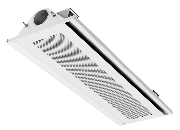Simply the natural choice
 Simply the natural choice
Simply the natural choice
Minimizing the energy cost for heating and cooling, by recovering the thermal energy from the exhaust air using a heat recovery unit is a natural part of any ventilation system today. It is a process that conserves the energy in the building, thereby saving huge amounts of energy required for heating and cooling. Why then do we not do the same with the water circuits?
Common Water Temperature
The Lindab Solus System does just that, by using High Temperature Cooling (HTC) and Low Temperature Heating (LTH) in one common set of water pipes working at a common inlet temperature. This means that regardless of whether the zone needs heating or cooling the inlet temperature remains constant allowing you to harvest the energy saving benefits this brings.
Depending on the season and the geographic location, there will always be a need for cooling or heating in any given building and in some cases, there will even be a need for simultaneous cooling and heating. In such cases the return water temperature will be higher or lower than that of the inlet water, dependant on which part of the building the water is coming from. As the return water from the various parts of the building are mixed together, the temperature will stabilize at a near ideal inlet temperature eliminating the need for the engagement of both boilers and chiller plant.
To ensure that the system performs properly, a constant water volume flow rate is used throughout the entire system. This ensures that all the excess heat energy that may exist in some parts of the building, will in turn be carried to cooler areas, thereby creating an energy balance in the building. If the water flow is reduced, the energy transfer between the rooms will also be reduced, resulting in a less efficient system.
The traditional method of sizing a cooling or heating system has been to seek high temperature differences (DeltaT rw) between the water circuit and the room air temperature to save money in the construction phase. Normally, a chilled beam cooling system will run at quite low water temperatures of 14°C, whereas a heating system will run quite high water temperatures (50°C) to achieve as high a difference in the temperature between the water and the room air as possible. The higher the difference in temperature, the higher the capacity. With the Lindab Solus System the temperature difference (DeltaT rw) is extremely low. Accordingly the coil efficiency needs to be extremely high. The coil fitted in the Lindab Solo System beam delivers previously unseen efficiency levels and thereby delivers a high capacity despite the low temperature differences between the room air and water.
By moving away from the low cooling temperatures and the high heating temperatures, you end up having a common inlet temperature to the beams’ coil for both. Effectively, this means that it is possible to run an inlet temperature of between 20-23 degrees Celsius on both heating and cooling and thereby satisfy both cooling and heating in the same single circuit system, at the same time.
Low Maintenance and High Comfort
In traditional chilled beam systems it is necessary to run both a chiller and a boiler at the same time to achieve optimal output temperatures, but with the Lindab Solus System it will never be necessary to run both at the same time. By running a common inlet water temperature of 20-23°C (set by the external air temperature) in the water circuit for all areas regardless of the need for heating or cooling, and mixing the outlet water together it will only be necessary to either marginally cool or heat the return water to achieve the desired inlet temperature once again. The reduction of plant run time has a positive effect on overall plant LCC.
An additional result of this is that there are also no control valves, actuators or room controllers needed in the individual rooms, providing a huge saving on the installation costs. The higher cooled water temperature also eliminates the need for pipe insulation and effectively removes condensation risk in the room, also reducing the array of sensors needed. Furthermore replacing the traditional 4 pipe system with a single circuit greatly simplifies the installation and greatly reduces material costs.
Due to the low temperature difference between the Solus System’s supply air temperature to the room and the room temperature, the risk of draught in cooling mode and room air stratification in heating mode are also removed, enhanced PPD & PMV levels can be expected, see CBCA technical paper TFS No. 001 Issue 2, January 2013.
Extended Free Cooling Potential
The Lindab Solus System provides large savings on the installation costs and a saving on the energy needed for cooling and heating in the building. The latter will depend on the configuration of the system and internal/external loads however the high cooled water temperatures is ideal for combining the Solus System with free cooling chillers, providing an additional large saving in energy costs.
In a commissioned study, 6 different, likely scenarios were focused on. When considering the energy savings for annual total cooling, the savings could be between 5.7 – 57.5%. The different scenarios will be applicable to different building depending on several factors, the scenario shown here is the most applicable, indicating an annual saving on the energy needed for cooling may be as much as 45%.
|
Free Cooling is applied in steps of 25%, according to the outdoor temperature. For modern effective free cooling equipment.
|
|
|
Percentage of free cooling [%]
|
25
|
50
|
75
|
100
|
|
Outdoor temperature,
Conventional chilled beams [°C]
|
13
|
12
|
11
|
10
|
|
Outdoor temperature
Lindab Solus [°C]
|
19
|
18
|
17
|
16
|
| |
|
|
|
|
|